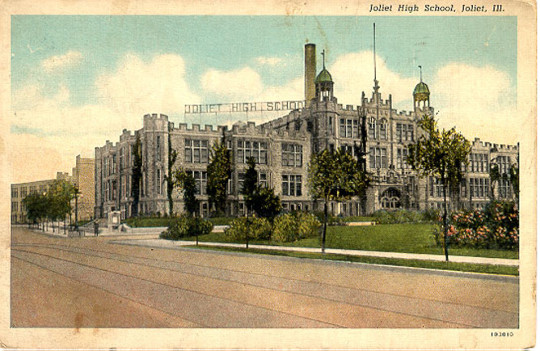 The first community college, with just 8 students, was housed in the local high school. room620jolietcentral.weebly.com
The first community college, with just 8 students, was housed in the local high school. room620jolietcentral.weebly.com
 ot since the 1960s has a sitting President engaged in issues around higher education as frequently as Barack Obama. He’s had little choice. With runaway student debt, diminishing state and federal investments, and the debate over the value it provides, higher education’s future is uncertain.
ot since the 1960s has a sitting President engaged in issues around higher education as frequently as Barack Obama. He’s had little choice. With runaway student debt, diminishing state and federal investments, and the debate over the value it provides, higher education’s future is uncertain.
Big ideas are required, and at this year’s State of the Union Address, President Obama rolled out his biggest idea yet when he called for “two years of (community) college…as free and universal in America as high school is today."
The President had barely “blessed” America and already Republicans were lining up to denounce his $60-billion plan and the tax hike intended to pay for it.
Predictably, they pilloried America’s College Promise Proposal as yet another Obama freebie – one more big government giveaway that would thwart innovative state-level policymaking, or worse, sap the community college system and its students, and possibly our entire political system, of its freedom and independence.
But if our elected officials were being honest, they’d have to admit that the federal government has been actively supporting community colleges and millions of students since the middle-decades of the last century, the first time a president called for free community college.
There’s A Long History
The public community college model traces its origins to Illinois and the founding of Joliet Junior College, southwest of Chicago, in 1901.
Slow but steady growth ensued over the next several decades, particularly in the western United States, as local leaders and pedagogues sought ways to provide their burgeoning populations with low-cost education options.
Typically this meant augmenting the local high school with a smattering of vocational and college preparatory classes, or re-purposing existing teacher-training institutes into two-year “people’s colleges.”
Then as now, boosters championed the model primarily as a gateway for poor and under-prepared students to ready themselves for transfer to a four-year college.
The reality was something different, however.
During the economic crisis of the 1930s the aims of these institutions irrevocably shifted to workforce training in “semiprofessional” fields such as stenography, typing, and bookkeeping – whatever vocational fields were then in shortest supply.
From FDR To Post War
President Franklin D. Roosevelt’s New Deal contributed directly to this reframing.
Economist Rexford Tugwell, a leading member of FDR’s “brain trust,” promoted adult retraining as a key weapon in the government’s fight against the Great Depression, believing that an educated workforce would be more creative, dynamic, and socially cohesive.
Harry Hopkins’ Works Progress Administration and Harold Ickes’ Public Works Administration, meanwhile, helped fund and staff campus construction projects, such as libraries and classroom buildings.
And, finally, the enactment of the George-Deen Act of 1936 authorized the distribution of federal funds to community colleges that agreed to use those funds for the provision of vocational coursework of “less than college grade.”
The New Deal was but a rehearsal for the real revolution in community colleges that followed World War II.
Once again, federal action played a vital role. The 1944 GI Bill of Rights provided veterans with generous educational subsidies that boosted attendance at all institutions, including the country’s 500 community colleges, where accommodating older students had become a core mission.
Demobilization of the military not only pushed enrollment up, it also resulted in the issuing of new equipment, surplus tools and machinery, the decommissioning of federally-run national defense training centers being just one example. This was especially true in California, a state that became ground zero of the burgeoning defense industry and home to the most vibrant community college system anywhere.
The agility of community colleges in the face of unprecedented demand and a booming postwar economy was not lost on policymakers.
In 1947 the release of Higher Education for American Democracy, a report commissioned by President Harry Truman, whose own education ended after a single term at a Kansas City area business college, brought national attention to the bustling two-year arena.
The Truman Report, as the six-volume study was more commonly known, declared that “the time has come to make education through the fourteenth grade available in the same way that high school education is now available.”
Groundbreaking In The 1950s And 60s
This never happened, of course. But the enactment of groundbreaking education legislation in the 1950s and 1960s, anchored by the Higher Education Act of 1965, included support for two-year colleges and for federal work study, loans, and grants that helped students pay for school.
Over the last five decades, tens of millions of students have used these tools to pay for college, with ever increasing numbers (approximately 40 percent of today’s students) electing to do so at one of the nation’s 1,100 community colleges.
This brings us to President Obama’s current proposal and the conversation that we should be having.
Rather than letting the debate turn on hoary ideological divides – Democrat versus Republican, big versus small government, federal versus local control – we ought to judge the plan on its merits.
Is the community college system really up to the task of delivering the educated workers and citizens that our innovation economy needs?
During the twentieth century the US higher education system grew increasingly dependent on public support, and no part of that system would run well today in the absence of federal largess – not research universities, not liberal arts colleges, not for-profit outfits, and certainly not community colleges.
Owning up to this history should remind us that community colleges are a precious local and national resource, and part of a much larger community than we probably realized.
This article was originally published on The Conversation
Read the original article.
About The Author
 Christopher P. Loss is an Associate Professor of Public Policy and Higher Education at Vanderbilt University. He is a historian of the twentieth century United States who specializes in the political, social, and policy history of U.S. higher education. His publications include peer-reviewed articles and essays in the Journal of American History, the Journal of Policy History, Social Science History, Perspectives on the History of Higher Education, the History of Education Quarterly, and History of Psychology, among others.
Christopher P. Loss is an Associate Professor of Public Policy and Higher Education at Vanderbilt University. He is a historian of the twentieth century United States who specializes in the political, social, and policy history of U.S. higher education. His publications include peer-reviewed articles and essays in the Journal of American History, the Journal of Policy History, Social Science History, Perspectives on the History of Higher Education, the History of Education Quarterly, and History of Psychology, among others.
InnerSelf Recommended Book
 Degrees of Inequality: How the Politics of Higher Education Sabotaged the American Dream
Degrees of Inequality: How the Politics of Higher Education Sabotaged the American Dream
by Suzanne Mettler.
Click here for more info and/or to order this book on Amazon.






















